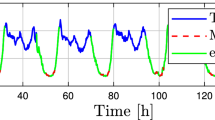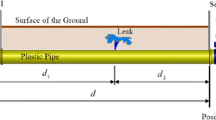Abstract
A numerical approach, named as leak detection simulated annealing (LDSA), is developed based on the combination of transient flow simulations and simulated annealing to detect leaks in a pipe network. In the LDSA framework, an analysis model for pipe networks is first used to determine the steady-state nodal head solution of the network. For detecting the leaks, a valve closing suddenly at downstream side of the network is designed to create a transient event and then the method of characteristic is applied to simulate the transient flow in the network. Results from an experiment on leak detection in a single pipeline presented in the literature are used to verify the capability of LDSA in identifying the leaks. The result shows that the leaks represented by orifices in two cases can be accurately detected. The effect of C d A (discharge coefficient times effective area of orifice) on the detection is evaluated. In addition, three scenarios with three cases in each scenario are designed to test the performance of LDSA in numerical experimental studies for a synthetic network. For a very small value of C d A, it is found that the use of multiple observation points can increase the detection capability.






Similar content being viewed by others
References
Abhulimen KE, Susu AA (2004) Liquid pipeline leak detection system: model development and numerical simulation. Chem Eng J 97(1):47–67
Al-Khomairi A (2008) Leak detection in long pipelines using the least squares method. J Hydraul Res 46(3):392–401
Beck SBM, Curren MD, Sims ND, Stanway R (2005) Pipeline network features and leak detection by cross-correlation analysis of reflected waves. J Hydraul Eng ASCE 131(8):715–723
Brennan MJ, Gao Y, Joseph PF (2007) On the relationship between time and frequency domain methods in time delay estimation for leak detection in water distribution pipes. J Sound Vib 304(1–2):213–223
Brunone B (1999) Transient test-based technique for leak detection in outfall pipes. J Water Resour Plan Manag ASCE 125(5):302–306
Chaudhry MH (1987) Applied Hydraulic Transients, 2nd edn. Van Nostrand Reinhold, New York
Colombo AF, Lee P, Karney BW (2009) A selective literature review of transient-based leak detection methods. J Hydro Environ Res 2(4):212–227
Covas D, Ramos HM (2010) Case studies of leak detection and location in water pipe systems by inverse transient analysis. J Water Resour Plan Manag ASCE 136(2):248–257
Covas D, Ramos HM, Graham N, Maksimovic C (2004a) Application of hydraulic transient for leak detection in water supply system. Water Sci Technol Water Supply 4(5–6):365–374
Covas D, Stoianov I, Mano J, Ramos HM, Graham N, Maksimovic C (2004b) The dynamic effect of pipe-wall viscoelasticity in hydraulic transients, part I-experimental analysis and creep characterization. J Hydraul Res 42(5):516–530
Covas D, Ramos HM, Almeida AB (2005) Standing wave difference method for leak detection in pipeline systems. J Hydraul Eng ASCE 131(12):1106–1116
Douglas JF, Gasiorek JM, Swaffield JA, Jack BL (2005) Fluid mechanics, 5th edn. Harlow, England
Duan HF, Lee PJ, Ghidaoui MS, Tung YK (2010) Essential system response information for transient-based leak detection methods. J Hydraul Res 48(5):650–657
Duan HF, Lee PJ, Ghidaoui MS, Tung YK (2012) System response function–based leak detection in viscoelastic pipelines. J Hydraul Eng ASCE 138(2):143–153
Emara-Shabaik HE, Khulief YA, Hussaini I (2002) A non-linear multiple-model state estimation scheme for pipeline leak detection and isolation. Proc Inst Mech Eng J Syst Control Eng 216(6):497–512
Ferrante M, Brunone B (2003) Pipe system diagnosis and leak detection by unsteady-state tests. 1. Harmonic analysis. Adv Water Resour 26(1):95–105
Ferrante M, Brunone B, Meniconi S (2007) Wavelets for the analysis of transient pressure signals for leak detection. J Hydraul Eng ASCE 133(11):1274–1282
Ferrante M, Brunone B, Meniconi S (2009) Leak detection in branched pipe systems coupling wavelet analysis and a Lagrangian model. J Water Supply Res Technol AQUA 58(2):95–106
Giustolisi O, Savic D, Kapelan Z (2008) Pressure-driven demand and leakage simulation for water distribution networks. J Hydraul Eng ASCE 134(5):626–635
Gong J, Lambert MF, Simpson AR, Zecchin AC (2013) Single event leak detection in pipeline using first three resonant responses. J Hydraul Eng ASCE 139(6):645–655
Haghighi A, Ramos HM (2012) Detection of leakage freshwater and friction factor calibration in drinking network using central force optimization. Water Resour Manag 26(8):2347–2363
Karney B, Khani D, Halfawy MR, Hunaidi O (2008) A Simulation study on using inverse transient analysis for leak detection in water distribution networks. In: Proceedings of the International Stormwater and Urban Water Systems Modeling Conference, Toronto, Ontario
Kirkpatrick S, Gelatt CD Jr, Vecchi MP (1983) Optimization by simulated annealing. Science 220(4598):671–680
Larock BE, Jeppson RW, Watters GZ (2000) Hydraulics of Pipeline Systems. CRC Press, Boca Raton
Lee PJ, Vitkovsky JP, Lambert MF, Simpson AR, Liggett JA (2005) Frequency domain analysis for detecting pipeline leaks. J Hydraul Eng ASCE 131(7):596–604
Liggett JA, Chen LC (1994) Inverse transient analysis in pipe networks. J Hydraul Eng ASCE 120(8):934–955
Nash GA, Karney B (1999) Efficient inverse transient analysis in series pipe systems. J Hydraul Eng ASCE 125(7):761–764
Nazif S, Karamouz M, Tabesh M, Moridi A (2010) Pressure management model for urban water distribution networks. Water Resour Manag 24(3):437–458
Pudar RS, Liggett JA (1992) Leaks in pipe networks. J Hydraul Eng ASCE 118(7):1031–1046
Puust R, Kapelan Z, Savic DA, Koppel T (2010) A review of methods for leakage management in pipe networks. Urban Water J 7(1):25–45
Sattar AM, Chaudhry MH (2008) Leak detection in pipelines by frequency response method. J Hydraul Res 46(1):138–151
Shamloo H, Haghighi A (2009) Leak detection in pipelines by inverse backward transient analysis. J Hydraul Res 47(3):311–318
Shamloo H, Haghighi A (2010) Optimum leak detection and calibration of pipe networks by inverse transient analysis. J Hydraul Res 48(3):371–376
Swamee PK, Sharma AK (2008) Design of water supply pipe networks, 1st edn. Hoboken, New Jersey
Swamee PK, Swamee N (2007) Full-range pipe-flow equations. J Hydraul Res 45(6):841–843
Verde C, Visairo N, Gentil S (2007) Two leaks isolation in a pipeline by transient response. Adv Water Resour 30(8):1711–1721
Vitkovsky JP, Simpson AR, Lambert MF (2000) Leak detection and calibration using transients and genetic algorithms. J Water Resour Plan Manag ASCE 126(4):262–265
Vitkovsky JP, Liggett JA, Simpson AR, Lambert MF (2003) Optimal measurement site locations for inverse transient analysis in pipe networks. J Water Resour Plan Manag ASCE 129(6):480–492
Vitkovsky JP, Lambert MF, Simpson AR, Liggett JA (2007) Experimental observation and analysis of inverse transients for pipeline leak detection. J Water Resour Plan Manag ASCE 133(6):519–530
Wylie EB, Streeter VL, Suo L (1993) Fluid Transients in Systems. Prentice-Hall, Englewood Cliffs
Yeh HD (1987) Theis’s solution by nonlinear least-squares and finite-difference Newton’s method. Ground Water 6(25):710–715
Yeh HD, Chen YJ (2007) Determination of skin and aquifer parameters for a slug test with wellbore-skin effect. J Hydrol 342(3–4):283–294
Yeh HD, Lin YC (2008) Pipe network system analysis using simulated annealing. J Water Supply Res Technol AQUA 57(5):317–327
Yeh HD, Chang TH, Lin YC (2007a) Groundwater contaminant source identification by a hybrid heuristic approach. Water Resour Res 43:W09420
Yeh HD, Lin YC, Huang YC (2007b) Parameter identification for leaky aquifers using global optimization methods. Hydrol Process 21(7):862–872
Acknowledgments
Research leading to this work has been partially supported by the grants from Taiwan National Science Council under the contract numbers NSC 101-2221-E-009-105-MY2 and 102-2221-E-009-072-MY2.
Author information
Authors and Affiliations
Corresponding author
Rights and permissions
About this article
Cite this article
Huang, YC., Lin, CC. & Yeh, HD. An Optimization Approach to Leak Detection in Pipe Networks Using Simulated Annealing. Water Resour Manage 29, 4185–4201 (2015). https://doi.org/10.1007/s11269-015-1053-4
Received:
Accepted:
Published:
Issue Date:
DOI: https://doi.org/10.1007/s11269-015-1053-4




